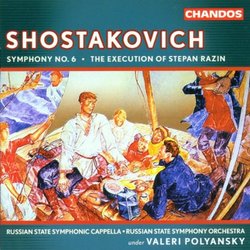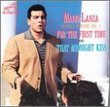| All Artists: Dmitry Shostakovich, Valery Polyansky, Russian State Symphony Orchestra Title: Shostakovich: Symphony No. 6; Execution of Stepan Razin Members Wishing: 0 Total Copies: 0 Label: Chandos Release Date: 1/22/2002 Genre: Classical Styles: Opera & Classical Vocal, Historical Periods, Modern, 20th, & 21st Century, Symphonies Number of Discs: 1 SwapaCD Credits: 1 UPC: 095115981320 |
Search - Dmitry Shostakovich, Valery Polyansky, Russian State Symphony Orchestra :: Shostakovich: Symphony No. 6; Execution of Stepan Razin
 | Dmitry Shostakovich, Valery Polyansky, Russian State Symphony Orchestra Shostakovich: Symphony No. 6; Execution of Stepan Razin Genre: Classical
|
Larger Image |
CD DetailsSimilar CDs |
CD ReviewsThe Best Case Yet for Shostakovich's Sixth Thomas F. Bertonneau | Oswego, NY United States | 04/12/2002 (5 out of 5 stars) "Dmitri Shostakovich (1906-1975), having "rehabilitated" himself with his Fifth Symphony (originally and ironically subtitled "A Soviet Artist's Reply to Just Criticism") in 1938, promised his hopeful overseers a sequel, hinting that the new symphony, the Sixth, would be "about Lenin." It would perhaps be a choral symphony, he suggested, setting Mayakovsky's verses about the Bolshevik leader. Some evidence exists that Shostakovich actually set to work on this project but abandoned it for a purely instrumental symphony without any announced program. Why? It was perhaps because, having fallen afoul of Stalin once, on account of the too-radical Fourth Symphony and the opera "Lady Macbeth of Mtsensk" (1934 and 1936), he worried about doing so again. Stalin was touchy about Lenin and getting mixed up with Mayakovsky's words was to court the dictator's displeasure. Instead of a monumental choral symphony, then, the Sixth emerged in 1939 as a three movement work with some internal asymmetry, as the First Movement Largo needs more than twice the performing time demanded by the two succeeding movements, an Allegro and a Presto, both burlesque in character. Critics have complained ever since that the work is lopsided and contradictory and that it represents a lapse in the succession of Shostakovich's symphonies. One solution is to push the Largo along, bringing it in at sixteen or seventeen minutes: this means that the Allegro and the Presto, together, more nearly balance the big, weighty movement. Those who have followed Valeri Polyansky's Shostakovich cycle for Chandos, with the Russian State Symphony Orchestra, will know in advance that this is not the path that he will take. Polyansky does not take matters as far as André Previn once did, but his nineteen minutes are a mere sixty seconds faster than Previn's twenty, with a London orchestra, on EMI. The rationale for a long-drawn and brooding treatment of this darkly colored essay in the polyphonic development of motifs is that this is one of the most Mahlerian movements that Shostakovich, a keen Mahler admirer, penned: it forecasts the great, pensive, sometimes nightmarish slow movements that begin the Eighth and Tenth and Eleventh Symphonies - it especially anticipates the opening Adagio of the Eleventh. Some commentators, including the booklet writer Eric Roseberry, speak of the Bachian contrapuntal character of the Largo, but it is really Bach as filtered through Mahler. Polyansky brings out not only the forecasts of later symphonic first movements by the composer, but the anticipation, for example, of the heart-rending sow movement of the Seventh Symphony of two years later. Polyansky tones down the vaudevilles and grotesqueries of the two fast movements, both of them scherzos of a sort, finding in them echoes of the Largo's darkness and moodiness. The result is one of the more convincing performances of this orphan among Shostakovich's later symphonies (the sequence that starts with the Fifth). The "Vocal-Symphonic Poem for Bass, Chorus, and Orchestra" called "The Execution of Stepan Razin" comes from 1964 and sets verses by Yevgeny Yevtushenko, who also provided the text for the Thirteenth Symphony, "Babi Yar." Shostakovich originally thought of the work as the first movement of a colossal choral symphony. It is an electrifying work full of the renewed daring of the composer's late style. Listen to the brass payers, who open with an angular motif that provides the much-transformed motto for the remainder of the score: the precision of their playing is remarkable. The grotesqueries of Yevtushenko's poem find reflection in Shostakovich's talent for poignant instrumental combinations of the most unexpected sort. Polyansky in turn presents these in sharpened fashion. The solo and choral singing is fine throughout. "The Execution" has been recorded very rarely and it is good to have this modern version in the fine acoustic provided by Chandos. Recommended." Musically interesting, but ..... A. C. Richardson | Rockville, MD USA | 01/21/2006 (3 out of 5 stars) "My personal benchmark for listening to "The Execution of Stepan Razin" is the 1967 Angel/Melodiya LP record, which exhibits a far more dramatic presentation of this powerful work. The conductor (Polyansky) on this CD seems to be in far too much of a hurry to get this finished; and the rapid tempo and frantic instrumentation detracts from the drama for me, despite the very excellent vocals. I would recommend that you listen to the sample provided here by Amazon. If you like the fast tempo, then you will be very happy with this performance. I also was a bit disappointed with this Chandos CD audio as it sounded on my B&W 802 speakers; maybe a different speaker selection would give the sound more color and fullness."
|

 Track Listings (4) - Disc #1
Track Listings (4) - Disc #1

